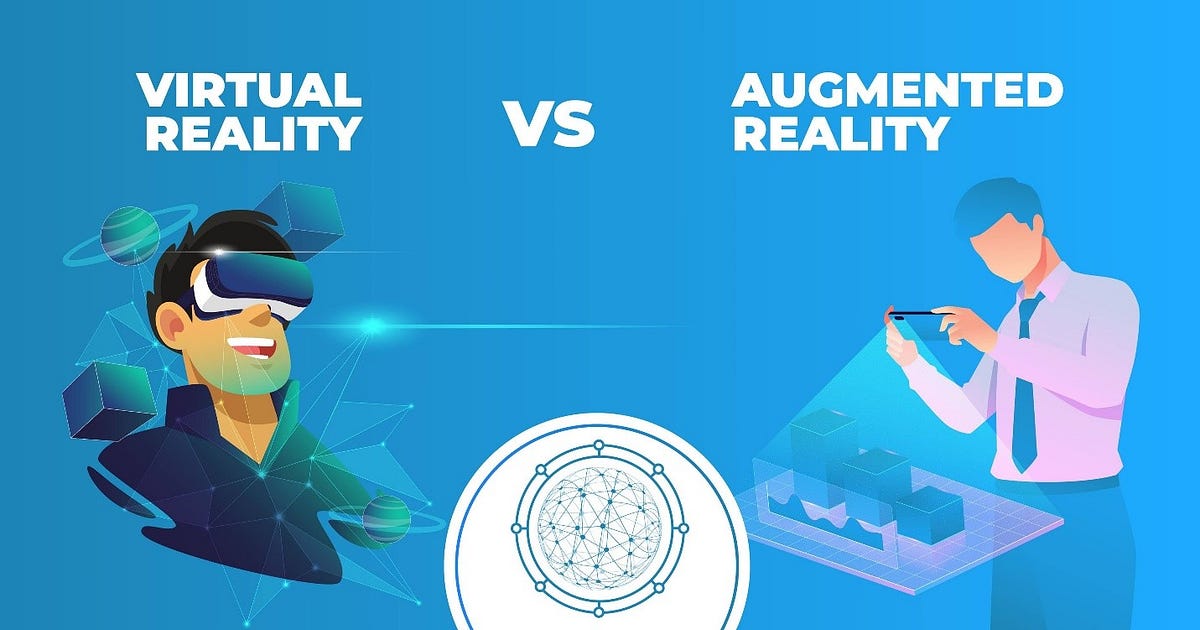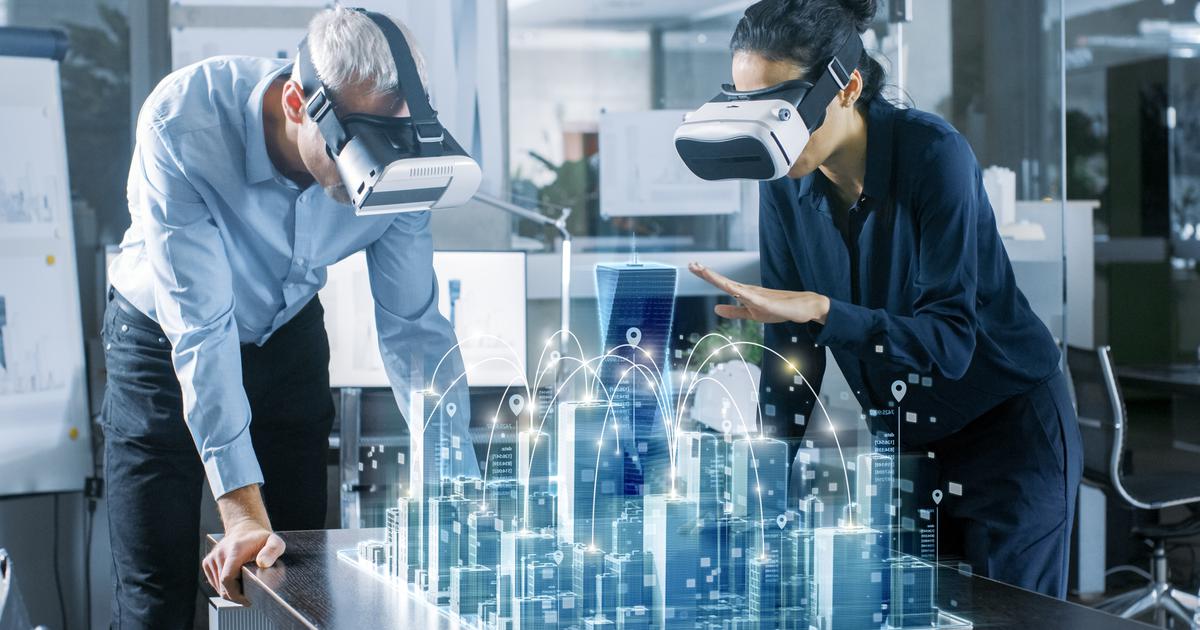Virtual Reality vs. Augmented Reality: Unraveling the Differences
In a world where technology constantly pushes the boundaries of what’s possible, two terms have become increasingly prevalent: Virtual Reality (VR) and Augmented Reality (AR). These immersive technologies are not only transforming the way we interact with the digital realm but also how we perceive our own reality. To truly appreciate their impact, it’s essential to understand the differences between them. So, let’s embark on a journey to explore the intricacies of VR and AR, what sets them apart, and how they are shaping the world around us.
Setting the Stage: The Rise of Virtual and Augmented Reality
The rise of Virtual and Augmented Reality is a testament to humanity’s unceasing thirst for innovation. Over the years, both VR and AR have moved from the fringes of science fiction to the forefront of technological advancement.
Virtual Reality, as a concept, has roots in the 19th century. Stereoscopes and early flight simulators laid the groundwork for modern VR. However, it wasn’t until the late 20th century that the term “Virtual Reality” was coined, and the technology started to resemble what we know today.
Augmented Reality, on the other hand, can trace its lineage back to the 1960s, when computer scientist Ivan Sutherland created the first head-mounted display system, a precursor to modern AR glasses. But AR only truly entered the public consciousness with the advent of smartphones, which put AR apps in the hands of millions.
In recent years, the ascent of VR has been driven by immersive gaming experiences, while AR found its early footing in the form of Pokémon GO, an augmented reality game that sent players hunting for virtual creatures in the real world.
Why Understanding the Differences Matters
Why is it important to distinguish between VR and AR? Well, because they offer contrasting experiences and applications. Whether you’re a tech enthusiast, a developer, or simply curious about these emerging realms, understanding the disparities is crucial.
The Basics

What is Virtual Reality?
A Dive into the Virtual World
Virtual Reality, at its core, is about creating an artificial environment that immerses the user. It’s a plunge into a meticulously crafted world, where you don’t just view or interact with objects; you become a part of them. It’s the feeling of being inside the game, movie, or simulation, rather than just an observer.
VR relies on specialized hardware to achieve this sense of immersion. Headsets like the Oculus Rift or HTC Vive encase your field of vision in a digital landscape. They track your head movements, adjusting the view accordingly, providing a 360-degree perspective. Some advanced systems incorporate hand controllers and room-scale tracking to enhance interactivity.
VR Hardware and Software
To make the magic of VR happen, you need the right tools. High-quality VR experiences demand sophisticated hardware and software. Headsets like the Valve Index and Oculus Quest 2 employ a blend of sensors, cameras, and screens to create a virtual world that mirrors your physical actions.
VR content is created using specialized software development kits (SDKs) that allow developers to build immersive applications. Game engines like Unity3D and Unreal Engine power many of the most popular VR experiences. These software tools integrate elements like 3D modeling, physics simulation, and real-time rendering to create the virtual environments users can explore.
Real-World Applications of VR
While VR is often associated with gaming, its applications stretch far beyond entertainment. In the field of medicine, VR is revolutionizing surgical training. Surgeons can practice intricate procedures in a risk-free environment, refining their skills and reducing the likelihood of errors during actual surgeries. Architectural and industrial design benefit from VR as well, providing designers with an immersive platform to test concepts and prototypes.
VR also plays a crucial role in treating psychological conditions like post-traumatic stress disorder (PTSD) and phobias. Exposure therapy in a controlled VR environment allows patients to confront and manage their fears. Educational institutions are using VR to create engaging lessons and field trips that take students to places and eras previously only accessible in textbooks.
What is Augmented Reality?
Blending the Real and Virtual Worlds
Augmented Reality is all about enhancing your perception of the real world by overlaying it with digital information. It’s the virtual world harmoniously coexisting with the physical world around you. Imagine wearing AR glasses and seeing your surroundings, but with real-time data, directions, or playful animations superimposed on your field of view.
AR’s beginnings can be traced to the early 1990s, but it gained mainstream attention with the rise of smartphones. Apps like Snapchat and Pokémon GO showcased AR’s potential in everyday life.
AR Devices and Platforms
Accessing AR experiences can be as simple as using your smartphone. Popular applications like Snapchat and Instagram integrate AR filters and effects that alter your appearance or surroundings. But for a more immersive and hands-free experience, dedicated AR hardware is the key.
Devices like Microsoft’s HoloLens and the Google Glass offer AR in the form of smart glasses. They use sensors, cameras, and projectors to interact with your surroundings and project digital elements seamlessly into your field of vision. Smartphones, with their cameras and processing power, are also integral to AR, making it accessible to a broad audience.
Real-World Applications of AR
Augmented Reality’s real-world applications are diverse. AR navigation apps, like Google Maps, provide real-time directions overlaid on your smartphone screen, making it easier to find your way in an unfamiliar city. AR is also revolutionizing shopping by allowing you to “try on” clothing or visualize furniture in your own home using apps like IKEA Place.
In healthcare, AR is used for medical training, offering students and professionals interactive anatomy lessons. Imagine being able to see the human body’s internal systems projected onto a physical model. Industrial and maintenance tasks are made more efficient with AR, as workers receive step-by-step instructions overlaid on the equipment they’re repairing. This reduces the need for extensive training and minimizes the chance of errors.
Core Concepts
Immersion in Virtual Reality
Presence and Its Importance
Presence is the cornerstone of a compelling VR experience. It’s the sensation that you’re not merely looking at a digital world but that you’ve stepped into it. This feeling of “being there” is what sets VR apart from other media.
Presence is achieved through a combination of factors, including high-quality visuals, realistic audio, and precise tracking of your movements. A high-resolution display with a fast refresh rate reduces the screen-door effect (the visible grid of lines that can appear in some VR headsets). Realistic audio, with 3D positional sound, enhances the illusion of being in a different world. Accurate tracking of your head movements ensures that what you see aligns with your real-world movements, enhancing the sense of immersion.
Degrees of Immersion
VR experiences can vary in their degree of immersion. At one end of the spectrum, you have smartphone-based VR, which provides a basic level of immersion but may lack the full interactivity and realism found in higher-end systems. Standalone VR headsets, like the Oculus Quest 2, offer a more immersive experience with head and hand tracking. PC-based VR systems, such as the Valve Index or HTC Vive, provide the highest level of immersion, with precise tracking and powerful hardware.
Degrees of immersion can also be categorized by the level of interactivity and the extent to which your physical movements are replicated in the virtual world. Room-scale VR, for instance, allows you to physically walk around and interact with the environment, creating a deep sense of immersion.
The Overlapping Realities of Augmented Reality
Understanding Spatial Mapping
Spatial mapping is the unsung hero of AR technology. It’s the process by which AR devices understand the physical space around you, enabling them to accurately overlay digital information. This spatial awareness is achieved through a combination of sensors, cameras, and algorithms.
AR devices scan your environment, creating a digital representation of the space. This enables them to place digital objects precisely in relation to the real world. The device knows where your walls, furniture, and other objects are, ensuring that virtual objects behave as if they truly exist in your space.
Interactive Digital Overlays
What sets AR apart is its interactive nature. While in VR, you’re typically navigating entirely digital spaces, AR lets you engage with digital objects in the context of your real surroundings. For example, using AR glasses, you can have digital chess pieces on your coffee table or receive step-by-step cooking instructions on your kitchen counter.
The key to this interactivity is the fusion of real-world objects with digital elements. This fusion is made possible by AR devices’ ability to understand and interact with the environment. It’s not just about seeing a digital overlay; it’s about manipulating and engaging with it in real-time.
Hardware and Devices

VR Headsets: A Window to Other Worlds
PC-Based VR Systems
If you’re looking for the most immersive VR experience, PC-based systems like the Valve Index and HTC Vive are the way to go. These headsets are tethered to a powerful gaming PC, which provides the processing muscle needed to render complex VR environments with high fidelity.
PC-based VR systems offer a higher level of detail, faster refresh rates, and a wider field of view than their standalone or mobile counterparts. This results in a more realistic and immersive experience. Additionally, many PC-based VR systems support room-scale tracking, enabling you to walk around in the virtual world.
Standalone VR Headsets
Standalone VR headsets, like the Oculus Quest 2, offer a compromise between high-end PC-based systems and mobile VR. They are self-contained, meaning they have all the necessary hardware, including processors, displays, and tracking sensors, built into the headset. This means you can enjoy a relatively high level of VR immersion without the need for a powerful gaming PC or any external sensors.
One notable feature of standalone VR headsets is their ability to operate in room-scale mode without the need for external sensors or base stations. This makes them more accessible and user-friendly, as they can be set up almost anywhere.
Mobile VR Platforms
If you have a smartphone, you already have access to basic VR experiences. Mobile VR platforms like Google Cardboard or Samsung Gear VR offer a cost-effective entry into the world of virtual reality. These platforms rely on your smartphone’s processing power and display to provide a VR experience.
While mobile VR can’t match the graphical fidelity or tracking accuracy of PC-based systems, it’s an excellent introduction to VR for those on a budget. Mobile VR also benefits from a growing library of apps and games available for download on your smartphone.
AR Glasses: Bringing Augmented Worlds to Life
A Glimpse into AR Glasses Evolution
The evolution of AR glasses has been nothing short of remarkable. The technology has come a long way since the infamous Google Glass, which, while ahead of its time, failed to gain mainstream acceptance due to privacy concerns and design issues.
Today, AR glasses are smaller, sleeker, and more powerful. Leading the charge is the Microsoft HoloLens series, which offers advanced AR experiences for enterprise and industrial applications. The HoloLens 2, for instance, provides an immersive field of view and robust spatial mapping capabilities.
Smartphones as AR Tools
While AR glasses have made significant progress, smartphones remain a vital tool for AR applications. The ubiquity of smartphones and their built-in cameras makes them an ideal platform for AR experiences.
AR apps on smartphones have gained popularity in a variety of fields. One notable example is the use of AR in navigation apps, such as Google Maps. By overlaying arrows and directions on your smartphone’s camera feed, these apps make it easier to navigate unfamiliar environments. Likewise, shopping apps have integrated AR features, allowing you to visualize how furniture or clothing would look in your own space.
Experiencing VR and AR

Navigating Virtual Reality
VR Content and Games
Virtual Reality is a playground for the imagination, offering immersive experiences that can be both entertaining and educational. Video games have been at the forefront of VR content, providing players with the opportunity to explore virtual worlds and interact with them on a profound level.
Games like “Half-Life: Alyx” and “Beat Saber” have demonstrated the gaming potential of VR. “Half-Life: Alyx” plunges players into a gripping science fiction narrative, while “Beat Saber” challenges their reflexes and rhythm as they slice through a storm of virtual beats with lightsabers.
Apart from gaming, VR offers a wide range of experiences. You can explore virtual art galleries, attend live music concerts, or even visit distant locations without leaving your home. Educational VR content is also on the rise, with applications like “Google Earth VR” allowing users to explore the world as if they were giants.
The Role of Controllers
In VR, controllers are the bridge between the digital realm and your physical actions. These devices allow you to interact with the virtual world, whether you’re wielding a sword, drawing in 3D space, or simply navigating a menu.
Controllers come in various forms, from the traditional handheld controllers to more complex devices like the Oculus Touch or Valve Index controllers. These advanced controllers track your hand movements and finger gestures, adding another layer of immersion to VR experiences.
Motion Tracking and Interactivity
Immerse yourself fully in VR with motion tracking and interactivity. When you move your head, your view within the virtual world adjusts accordingly. This tracking of your head movements, often referred to as 6-degrees-of-freedom (6DoF), is a significant contributor to the sense of immersion in VR.
In addition to head tracking, VR systems like the Valve Index, HTC Vive, and Oculus Rift provide room-scale tracking. This means that not only can you move your head, but you can also physically walk around in a defined play area. Room-scale VR amplifies the sense of presence, allowing you to reach out, pick up objects, and move freely within the virtual space.
Augmented Reality in Everyday Life
Enhancing Reality through Apps
Augmented Reality apps are seamlessly integrated into everyday life. They enhance your perception of the world by adding layers of information, entertainment, and utility to your surroundings. AR apps often leverage your smartphone’s camera and GPS capabilities to provide contextual and location-based experiences.
One of the most common uses of AR apps is in navigation. Apps like Google Maps utilize AR to overlay directional arrows and street names on your smartphone’s camera view, making it easier to navigate unfamiliar cities. This real-time guidance provides a more intuitive and interactive navigation experience.
Shopping apps are another area where AR has made a significant impact. Apps like IKEA Place allow you to visualize how furniture will fit and look in your home. You can see if that couch will fit in your living room or if the coffee table matches your décor. This feature empowers consumers with a new level of confidence when making purchasing decisions.
Gaming and Entertainment with AR
Augmented Reality is not just a tool for utility but a platform for entertainment as well. One of the most prominent examples is the global phenomenon, Pokémon GO. This mobile game uses AR technology to blend the virtual Pokémon world with the real world. Players explore their neighborhoods, parks, and cities, seeking out and capturing virtual creatures superimposed on their smartphone screens.
The success of Pokémon GO showcases how AR can encourage exploration and social interaction in the real world. Players gather at specific locations to participate in events, battle each other, and cooperate to capture rare Pokémon. It’s a testament to AR’s potential for creating shared experiences in the physical world.
Applications
VR vs. AR in Gaming
Immersive Gameplay in VR
VR gaming transcends traditional gaming experiences. It places you inside the game world, making you an active participant rather than a mere observer. The sense of presence in VR gaming is unparalleled, allowing you to inhabit different characters, explore fantastical realms, and engage with virtual objects as if they were real.
Games like “Half-Life: Alyx” take players on a thrilling journey through a post-apocalyptic world, where every interaction, from shooting enemies to solving puzzles, feels incredibly immersive. This level of engagement and immersion has made VR a game-changer in the gaming industry.
Gamifying the Real World with AR
Augmented Reality gaming is, in many ways, an extension of the real world. It encourages players to explore their surroundings and interact with digital elements seamlessly integrated into the physical environment. Games like “Pokémon GO” and “Harry Potter: Wizards Unite” transform city streets, parks, and landmarks into game arenas.
AR gaming encourages outdoor exploration, social interaction, and community building. It motivates players to visit specific locations, uncover hidden treasures, and collaborate in virtual adventures. The real-world gamification potential of AR offers a unique blend of entertainment and physical activity.
Education and Training: VR’s Classroom vs. AR’s Labs
Virtual Learning Environments
The educational landscape is undergoing a transformation with Virtual Reality. VR provides a platform for creating immersive virtual classrooms and learning environments. Students can participate in realistic simulations, conduct experiments, and visit historical or distant locations without leaving the classroom.
VR learning environments offer an engaging and interactive way to explore complex subjects. For example, students studying ancient history can step into a virtual representation of ancient civilizations, walking through the streets of Rome or Athens, and witnessing historical events firsthand.
Hands-On Training with AR
In the professional world, AR has proven to be a game-changer for training. It provides a hands-on, interactive learning experience that is particularly valuable in fields that demand precision and real-world application.
For example, in medical training, AR allows students to practice surgical procedures in a risk-free environment. They can operate on virtual patients, refining their skills without putting real lives at risk. The ability to simulate surgery with haptic feedback and realistic anatomical models enhances the training process.
AR is also making its mark in fields like engineering, where trainees can receive step-by-step instructions overlaid on real-world machinery. This type of on-the-job guidance reduces training time and minimizes the chances of errors.
Healthcare and Medical Use Cases
Surgery Simulations in VR
Virtual Reality is increasingly becoming a vital tool in the healthcare industry. One of its most significant applications is surgical training and simulations. VR allows medical professionals to practice and refine their surgical skills before they step into an operating room.
For example, surgical residents can use VR to familiarize themselves with complex procedures and hone their dexterity. They can perform virtual surgeries on highly detailed anatomical models. These simulations provide a safe and low-stress environment for medical professionals to gain experience and improve their techniques.
VR surgery simulations aren’t limited to training. They are also used for pre-operative planning, allowing surgeons to review a patient’s unique anatomy and practice the surgery before performing it in reality. This level of preparation can lead to improved surgical outcomes and shorter recovery times for patients.
AR-assisted Diagnostics
Augmented Reality is playing a pivotal role in healthcare, particularly in diagnostics. AR applications can superimpose digital information on medical scans and real-time visuals, making it easier for medical professionals to interpret data and make more informed decisions.
For example, during surgery, AR can overlay critical information on a surgeon’s field of view, providing real-time guidance. This can include highlighting important structures, displaying vital signs, and showing the location of tumors or blood vessels. Such visual aids enhance a surgeon’s precision and reduce the risk of errors.
AR is also used in medical imaging and diagnostics. Radiologists can use AR to overlay 3D reconstructions of organs, tumors, or fractures on 2D images, helping them to better understand complex anatomical structures and identify abnormalities.
Industrial and Enterprise Applications
VR for Design and Prototyping
In the industrial sector, Virtual Reality has become an indispensable tool for design and prototyping. VR allows designers and engineers to create and visualize 3D models in an immersive environment. This process offers a level of realism and interaction that traditional 2D CAD models can’t match.
Designers can step into their creations, examine them from every angle, and even make real-time adjustments. This level of immersion enables teams to identify potential issues and iterate on designs much more effectively. VR design and prototyping reduce the need for costly physical prototypes and accelerate the product development process.
For architects, VR is a game-changer, allowing them to walk clients through 3D representations of buildings before they’re constructed. This immersive experience helps clients understand the scale, spatial relationships, and aesthetics of a design.
AR in Field Service and Maintenance
Field service and maintenance have been revolutionized by Augmented Reality. Technicians and workers can use AR glasses or mobile devices to access information and guidance while performing tasks.
Imagine a field technician wearing AR glasses, equipped with spatial mapping and voice commands, as they repair complex machinery. AR overlays provide step-by-step instructions, highlighting the components that need attention and displaying relevant data. This not only speeds up the repair process but also reduces the chances of errors.
AR is also being used in manufacturing settings, where workers receive real-time data on production lines, quality control, and assembly instructions. This seamless access to information enhances efficiency, reduces downtime, and improves the overall quality of products.
Social Interaction in Virtual and Augmented Worlds
Virtual Hangouts and Social VR
Virtual Reality offers a new dimension of social interaction. In the virtual realm, you can meet and hang out with friends, family, or even strangers from around the world. Social VR platforms, such as Facebook Horizon and VRChat, are gaining popularity, creating virtual spaces where users can gather and interact.
These platforms allow you to create personalized avatars, explore virtual worlds, and engage in activities together. You can attend concerts, play games, or simply chat while feeling like you’re in the same room. Virtual hangouts transcend geographical barriers, offering a sense of togetherness in the digital realm.
AR’s Impact on Social Media
Augmented Reality has made a significant impact on social media, transforming how we engage with our online personas. Snapchat’s AR filters and Instagram’s effects have become immensely popular, allowing users to add whimsical overlays to their photos and videos.
These AR effects aren’t just for fun; they’ve become a form of self-expression and communication. Whether it’s trying on virtual sunglasses or transforming into a cute animal, AR filters enable users to convey emotions, moods, and experiences in a playful and engaging manner.
AR also influences advertising and brand engagement. Companies have embraced AR filters and lenses as a way to connect with consumers, offering interactive and memorable experiences that boost brand recognition.
Challenges and Limitations

Motion Sickness and VR
Coping with the Virtual Reality Blues
While Virtual Reality offers unparalleled immersion, it’s not without its challenges. Motion sickness, also known as VR motion sickness or simulator sickness, can affect some users. This discomfort arises when there’s a disconnect between what you see in the VR headset and what your inner ear perceives.
To combat motion sickness, VR developers have employed various strategies. Improving hardware performance, such as higher refresh rates and lower latency, can help reduce motion sickness. Game developers are also implementing comfort settings like smooth locomotion options and field-of-view adjustments to cater to a broader audience.
Privacy Concerns in AR
AR Data Collection and Privacy Implications
Augmented Reality’s ability to augment our reality with digital information comes with a privacy trade-off. AR applications often collect data about your surroundings and how you use the technology. This data can include images, video, and location information.
This data collection can raise concerns about privacy and security. For example, if you’re using AR for navigation, your location data is being transmitted to the service provider. If you’re using AR for social media, your interactions and surroundings may be recorded and analyzed.
As AR technology continues to advance, it’s essential for users to be aware of data collection practices and opt for applications and devices that respect their privacy. Additionally, regulations and standards may evolve to address these concerns in the future.
Accessibility and Inclusivity
Ensuring Everyone Can Enjoy VR and AR
Technology should be accessible to all, regardless of physical or cognitive abilities. Ensuring that VR and AR experiences are inclusive is vital. It’s about making sure that everyone can enjoy the benefits of these technologies, regardless of their individual challenges.
For VR, this means designing interfaces and experiences that are navigable for people with disabilities. It involves creating content that can be experienced by those with various physical or cognitive impairments. It also means developing hardware that accommodates a wide range of users, from those with dexterity issues to those with visual impairments.
Cost and Accessibility
The Price of Immersion
Both VR and AR have different cost structures and accessibility factors.
In the world of Virtual Reality, high-end PC-based systems like the Valve Index or HTC Vive provide the most immersive experiences but require a substantial upfront investment. You’ll need a capable gaming PC, which can add to the overall cost. Standalone VR headsets, like the Oculus Quest 2, offer a balance between quality and affordability. Mobile VR platforms, such as Google Cardboard, offer an entry point with minimal cost, but with some limitations in terms of graphics and tracking.
On the Augmented Reality side, AR glasses like the Microsoft HoloLens or Google Glass come at a premium price point. While they offer advanced capabilities, their cost can be a barrier to entry for many consumers. Smartphone-based AR, on the other hand, is widely accessible, as it only requires a smartphone with a camera and AR-compatible apps.
The Future of VR and AR
The Evolving Landscape of VR
Emerging Technologies and Trends
The Virtual Reality landscape is in a constant state of evolution. New technologies and trends are shaping the future of VR. These developments are poised to take VR experiences to the next level.
One of the key trends in VR is the advancement of display technology. High-resolution screens with higher pixel density are reducing the screen-door effect, making VR experiences more lifelike. Additionally, foveated rendering technology, which focuses rendering resources on the area where the user is looking, promises to reduce the computational requirements and improve performance.
Wireless VR is another exciting development. Wireless headsets offer greater freedom of movement and eliminate the need for tethering to a PC. The Oculus Quest series has been at the forefront of this trend, offering a standalone VR experience with wireless capabilities.
VR Beyond Entertainment
Virtual Reality’s potential extends far beyond gaming and entertainment. It’s being embraced in various industries and fields. In architecture and design, VR is becoming a standard tool for presenting designs to clients and stakeholders. It offers a more intuitive way to explore and understand architectural plans.
In the field of therapy, VR is used for exposure therapy to treat phobias and post-traumatic stress disorder (PTSD). It provides a safe and controlled environment for patients to confront their fears and traumas.
Sports training is another area where VR is making an impact. Athletes use VR simulations to practice and improve their skills. VR can simulate game scenarios and enable athletes to train even when they’re not on the field.
AR’s Integration into Daily Life
Augmented Reality as a Game Changer
Augmented Reality is poised to be a game-changer in our daily lives. It’s expanding its reach into various aspects of our existence, making routine tasks more intuitive and enjoyable.
One of the most promising applications of AR is in navigation. AR navigation apps, like Google Maps, are evolving to provide more detailed and immersive directions. Imagine walking down a street and seeing virtual signposts, directions, and points of interest seamlessly overlaid on your field of view. This kind of navigation makes exploring unfamiliar places more engaging and less stressful.
In the world of shopping, AR is revolutionizing the way we make purchase decisions. Apps like IKEA Place allow you to visualize how furniture will fit in your home before you make a purchase. This type of AR experience enhances consumer confidence and reduces the likelihood of post-purchase disappointment.
AR and the Future of Work
The workplace is also undergoing an AR revolution. Augmented Reality is enhancing productivity and changing the way we work. In industries like field service and maintenance, technicians can access critical information in real-time, overlaying digital instructions on the physical equipment they’re repairing. This not only streamlines maintenance tasks but also reduces the need for extensive training.
AR also plays a vital role in telemedicine, enabling remote medical consultations with real-time data and guidance. Surgeons can receive assistance during procedures, and doctors can visualize patient data and medical images in a hands-free manner, enhancing their diagnostic capabilities.
Conclusion

Summing Up the Differences
In this comprehensive exploration, we’ve delved into the fundamental distinctions between Virtual Reality and Augmented Reality. VR immerses us in artificial worlds, whereas AR enhances our reality with digital overlays. Understanding these differences is essential to harness the full potential of both technologies.
How VR and AR Are Transforming the Way We Experience the World
As Virtual Reality and Augmented Reality continue to evolve, they are redefining not just how we experience digital content but also how we engage with our surroundings. These technologies are expanding the boundaries of human interaction with technology, and their impact on various industries is undeniable. The future promises even more exciting developments as these immersive realms become increasingly integrated into our lives.
From the evolution of VR hardware and the growing library of VR content to the seamless integration of AR into everyday life, the world of immersive technology is dynamic and promising. The challenges that arise, from motion sickness to privacy concerns, are being addressed, making these technologies more accessible and inclusive.
As we move forward, it’s essential to embrace the unique strengths of VR and AR and consider how they can enhance and enrich our daily experiences. Whether you’re a developer pushing the boundaries of immersive content or an enthusiast eager to explore new realities, the future of VR and AR holds a world of possibilities, waiting to be uncovered and shared.
FAQ
What is the key difference between Virtual Reality (VR) and Augmented Reality (AR)?
The primary distinction lies in how they interact with the real world. VR immerses users in entirely artificial environments, while AR enhances the real world with digital overlays.
What are the hardware requirements for a high-quality VR experience?
To achieve a high-quality VR experience, you typically need a powerful gaming PC, a compatible VR headset (like the Valve Index or Oculus Rift), and controllers for interaction.
How can Augmented Reality be used for navigation and location-based services?
AR navigation apps, like Google Maps, overlay real-time directions and points of interest on your smartphone’s camera view, making navigation more intuitive and interactive.
Are there any common challenges associated with Virtual Reality?
Motion sickness is a common challenge in VR, resulting from the disconnect between what you see in the headset and your inner ear’s perception of motion. It can be mitigated with strategies like improved hardware performance and comfort settings.
How does Augmented Reality enhance the shopping experience?
AR shopping apps, such as IKEA Place, allow consumers to visualize how furniture and other products will look in their homes before making a purchase, reducing post-purchase disappointment.
What are some of the real-world applications of VR in healthcare?
VR is used in surgical training, medical diagnostics, and therapy. It enables surgeons to practice and refine their skills, helps in interpreting medical data through AR overlays, and assists in exposure therapy for conditions like phobias and PTSD.
How does Augmented Reality impact social media and self-expression?
AR filters and effects on platforms like Snapchat and Instagram have transformed self-expression and communication, allowing users to convey emotions, moods, and experiences in a playful and engaging manner.
What are some emerging trends in the Virtual Reality landscape?
Emerging trends include advancements in display technology to reduce the screen-door effect, the rise of wireless VR headsets, and VR’s expansion beyond gaming into fields like architecture, therapy, and sports training.
What role does Augmented Reality play in the workplace, particularly in field service and maintenance?
AR enhances productivity by providing real-time information and instructions to technicians and workers, making maintenance tasks more efficient and reducing the need for extensive training.
How do VR and AR address privacy concerns and data collection?
VR and AR applications often collect data about their users’ surroundings. To address privacy concerns, it’s crucial for users to be aware of data collection practices and opt for applications and devices that respect their privacy. Future regulations and standards may also address these concerns.
In our previous post, “Applications of VR in Training and Simulations” we explored the fundamental distinctions between Virtual Reality (VR) and Augmented Reality (AR). Now, let’s dive deeper into the future of immersive technologies. Discover how these dynamic realms are evolving and how they are transforming industries in our latest article on immersive technology trends.
If you’re looking to stay updated on the latest developments in the world of technology and digital trends, head over to Medium. Their in-depth articles cover a wide range of topics, from emerging technologies to the impact of VR and AR on industries. Explore their insightful content to gain valuable insights into the ever-evolving tech landscape.




Uma resposta